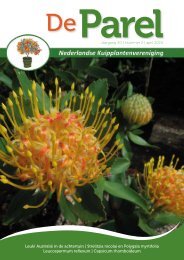december 2018 nummer 6
You also want an ePaper? Increase the reach of your titles
YUMPU automatically turns print PDFs into web optimized ePapers that Google loves.
Summary<br />
Rob Bregman<br />
Ben Wijffelaars looks forward to the weekend<br />
of 15-16 June 2019, when Succulenta<br />
will celebrate its centenary in the botanical<br />
garden of the Utrecht University. Ben feels<br />
that our hobby might as well survive for<br />
another 100 years, since he saw greenhouses<br />
with (plastic) plants on a cemetery in<br />
southern France.<br />
In his ongoing contributions on the ‘Verkade’<br />
cactus and succulent handbooks of<br />
the 1930’s, Theo Heijnsdijk deals with the<br />
‘button cactus’ Epithelantha micromeris. This<br />
well-known plant from the American-Mexican<br />
border area was discovered in 1849<br />
by Charles Wright and was first described<br />
in 1856 by Georg Engelmann as Mamillaria<br />
(with one ‘m’) micromeris. In 1922 L. Britton<br />
and J. Rose placed the plant in their new genus<br />
Epithelantha, because the flowers do not<br />
emerge from the axils (as in Mammillaria)<br />
but from the tubercles. In 1969, L. Benson<br />
described a second species: E. bokei. In<br />
2010, the Italians D. Donati and C. Zanovello<br />
distinguished 7 species, based on differences<br />
of the juveniles. E. micromeris is easily<br />
recognizable for its small globular habit with<br />
a white, short and dense spination, small<br />
whitish to rose-colored flowers (the smallest<br />
of all cacti) and the relatively large, scarlet<br />
elongated fruits.<br />
Bertus Spee presents another episode of<br />
‘in the spotlight’. This time, he discusses the<br />
genus Lithops, Mammillaria albicoma and<br />
Welwitschia mirabilis.<br />
Aat van Uijen visited a botanical garden in<br />
the state of Espirito Santo, Brazil, founded<br />
by the Brazilian botanist Robert Kautsky. His<br />
name lives on in Schlumbergera kautskyi, an<br />
epiphytic cactus from tropical woods. This<br />
plant resembles the well-known Christmas<br />
cactus S. truncata but the ovary of the flower<br />
is slightly different.<br />
Kees Jan van Zwienen and Kok van Herk<br />
proceed their series of articles on the cactus<br />
flora of Patagonia (southern Argentina and<br />
Chile) with short descriptions of the plants<br />
they came across (species of the genera<br />
Austrocactus, Maihuenia and Maihueniopsis).<br />
Madeleine Elizabeth reports about Epiphyllum<br />
anguliger. She sowed seeds but due to<br />
her impatience she bought an adult specimen.<br />
In a second contribution, Theo Heijnsdijk<br />
pays attention to the German painter Carl<br />
Spitzweg. A photo of two people admiring<br />
a cactus, published in Succulenta in 1931,<br />
reminded him of his work, which includes<br />
several paintings with a more or less similar<br />
image, for example ‘der Kaktusfreund’.<br />
André van Zuijlen disagrees with people<br />
who assert that sowing cacti is easy. A<br />
sowing test carried out by 7 participants<br />
yielded rather poor results. Even when<br />
germination is succesfull, the main cause<br />
of mortality is inadequate disinfection of<br />
the soil, so that fungi spores and sciara flies<br />
larvae can survive.<br />
Wolter ten Hoeve summarizes the contents<br />
of other journals on succulent plants.<br />
As usual in the December issue, indexes<br />
of all authors, articles and plant illustrations<br />
are listed alphabetically.<br />
On the back page, Tom Twijnstra remembers<br />
not being very amused when a friend<br />
gave him an Euphorbia trigona as a present.<br />
Later, an Euphorbia obesa changed his<br />
mind.<br />
R.Bregman@contact.uva.nl<br />
Succulenta jaargang 97 (6) <strong>2018</strong> 293

















